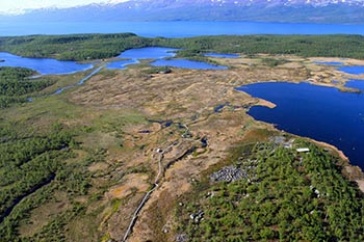UNH Receives $3.4 Million to Examine Effects of Climate Change on Arctic Ecosystems

Aerial view of lakes in Stordalen Mire in the region of Abisko, Sweden, a model ecosystem for researching methane emissions. Credit: Scott Saleska
DURHAM, N.H.—Researchers at the University of New Hampshire have been awarded a three-year grant totaling $3.4 million from the U.S. Department of Energy. The team will study the thawing of Arctic permafrost—ground or soil that remains frozen throughout the year—to see its effects on lakes and streams, potentially converting into methane or carbon dioxide, greenhouse gases that can fuel climate change.
“We know that the Arctic is warming at four times the rate of other places and when these frozen areas begin to thaw carbon—dead plant material—can be released into nearby lakes and streams where it can then be converted into gas emissions by microbes that further fuel the thawing cycle,” said Ruth Varner, professor of Earth sciences and lead principal investigator of the study. “Simply put, more methane equals more warming and trying to figure out the link between these microbes and the gas emissions is critical for dealing with climate change.”
The project, called the Gatekeepers of Arctic Carbon, will consist of a team of researchers from seven institutions focusing on the lakes in Stordalen Mire in the region of Abisko, Sweden, a model ecosystem where the lakes produce up to 50% of the methane emissions found in that area. The goal is to take a closer look at some key unknowns of carbon cycle climate feedback, the warming or thawing that can release carbon which is converted into emissions that can contribute to climate warming which in turn stimulates more thawing that releases yet more carbon, creating a cycle.
Researchers will study how the carbon is transformed chemically and the role the lake sediment plays as a gatekeeper—if it stores the carbon and how it is transformed into gas emissions. To further understand the process, scientists will focus on two types of microorganisms—methanogens which make methane and methanotrophs which consume methane. Earlier research found a high abundance of methanotrophs in ecosystems of similar lake and stream sediments. In this new research, the team will collect samples near the Arctic Circle to look at incubation rates of the methane consumption hoping to shine a light on how they work, how they live and survive and if they can isolate and grow them. The key is to identify the role they play in these Arctic ecosystems because of their importance in mitigating methane emissions, which are projected to increase with ongoing climate warming.
“The goal is to understand how warming can push microbial communities to change—which thrive and function better when it’s warmer and which mitigate the methane,” said Varner.
Other collaborating institutions include The Ohio State University, Colorado State University, University of Arizona, Florida State University, Berkeley Labs and Queensland University of Technology, Australia.
The University of New Hampshire inspires innovation and transforms lives in our state, nation and world. More than 16,000 students from all 50 states and 71 countries engage with an award-winning faculty in top-ranked programs in business, engineering, law, health and human services, liberal arts and the sciences across more than 200 programs of study. A Carnegie Classification R1 institution, UNH partners with NASA, NOAA, NSF and NIH, and received $260 million in competitive external funding in FY21 to further explore and define the frontiers of land, sea and space.
PHOTOS FOR DOWNLOAD:
Photo: https://www.unh.edu/unhtoday/sites/default/files/media/emerge_aerial_sweden_credit_scott_saleska.jpg
Caption: Aerial view of lakes in Stordalen Mire in the region of Abisko, Sweden, a model ecosystem for researching methane emissions.
Credit: Scott Saleska
Photo: https://www.unh.edu/unhtoday/sites/default/files/media/img_3115.jpg
Caption: Researchers collecting samples in lakes near the Arctic Circle to look at incubation rates of methane consumption to identify the role they play mitigating methane emissions in Arctic ecosystems.
Credit: UNH
Photo: https://www.unh.edu/unhtoday/sites/default/files/media/img_3261.jpg
Caption: Researchers collecting samples in lakes near the Arctic Circle to look at some key unknowns of carbon cycle climate feedback, the warming or thawing that releases carbon that is converted into emissions and contributes to climate warming.
Credit: UNH
Latest News
-
May 7, 2024
-
April 26, 2024
-
April 16, 2024
-
April 16, 2024
-
April 16, 2024
















































